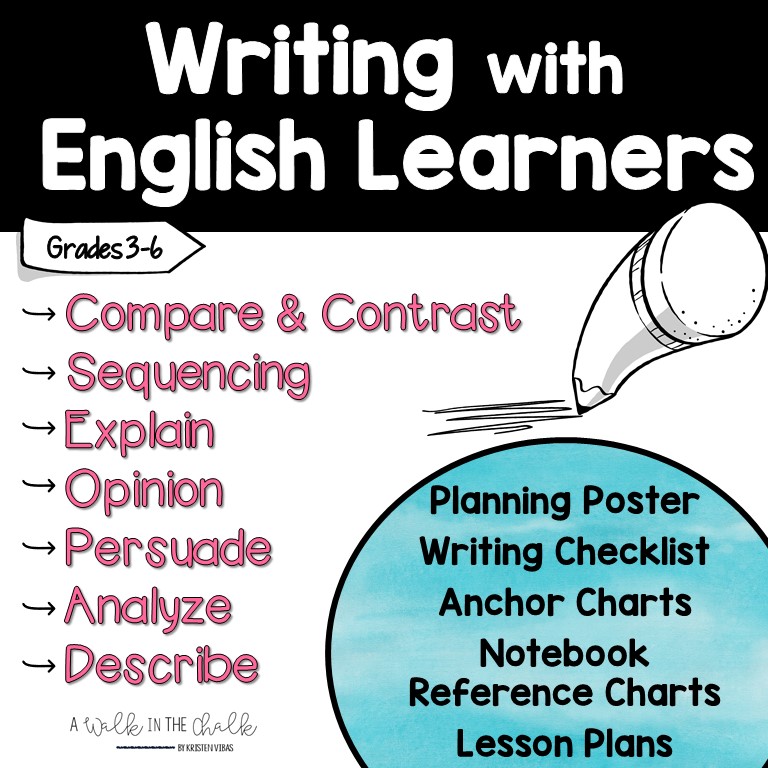There are certain times during the school day, particularly during Language Arts, when students are working independently to build their reading and writing skills. I often get asked, "What can my newcomers work on during independent class time?" Let me start by saying, newcomers, or beginning English learners, should always be included in classroom lessons and instruction, and the lessons and activities should always have language scaffolds in place so that even our beginners are learning and participating alongside everyone else. They should never be put on a computer just to be "doing something." With that said, let's talk about some meaningful activities our newcomers could work on independently. Here are my top suggestions for independent activities to build language with newcomers during independent class time.
1- Reading Books
Devoting part of the day to holding books, looking at books and reading books is important. Carve out time each day, or several times per week, where students are engaged independently with books. Providing books in a newcomer's native language is ideal, because we want them to still be reading; and if they read in their first language (L1), then let's put some books in their hands so they can read!
If you want your student to practice reading English using leveled books, this time could be well spent rereading familiar books, such as books you've read together during guided reading. Be cautious however, giving your sixth grader a bin full of kindergarten leveled books will likely cause embarrassment and could damage the self confidence you're working so hard to build. You might allow students to take these books home to practice, or have a bin at the guided reading table where they are reading a familiar book as a warm-up.
2- Online Books
One thing I really like about assigning online books during independent class time is options. Students have lots of choice when it comes to online books and websites, so finding a topic of interest can be easier. Also, I love that students can listen to the books first on many sites. This is great for building fluency, vocabulary and pronunciation. Holding a book in your hands is important, but online books are equally important, so assigning this activity to students several times a week is a great way to spend independent class time.
Some of my favorite FREE sites are:
Unite for Literacy - this site has books in Spanish, as well as narrations in many other languages.
EPIC Books - this is a must have for me and my students! This site is amazing.
Storyline Online - stories read aloud by SAG & AFTRA members. This one is my least used between the three, but I love the animated stories, and the read alouds are great for listening and building vocabulary.
Some of my favorite PAID sites are:
Raz-Kids - leveled books- students can listen before reading, as well as record themselves reading. Books also come in other languages!
Tumble Books - lots of great book choices on this site.
MyOn - my students enjoy the graphic novels a lot:)
With virtual learning this year, I jumped on the "Bitmoji Classroom" bandwagon and created clickable links in my virtual classroom. Having the links all in one place has provided easy access to my students. (Everything in the bookcase is hyperlinked!) I house my "Bitmoji Classroom" in my Google Classroom, pinned to the top of my Classwork page.
 |
| There are tons of YOU TUBE videos on how to create a Bitmoji Classroom:) |
3- Vocabulary Building Activities
Independent class time is a GREAT time to build or reinforce vocabulary! Introduce vocabulary first during small group instruction, then have students do follow up independent activities with those new terms. It's important to practice together first before expecting independent success.
Here a student is copying and illustrating the vocabulary from his reading lesson.
Flash cards are not recommended. IMO, this is a meaningless task. Instead, have students match, sort, illustrate or label. Students could also partner up with a class buddy giving opportunities to practice saying the words and hearing their native English speaking counterparts using the words.
I use the KIM strategy to explicitly teach new vocabulary, then as an independent activity students illustrate the words. If they are ready, they can use the new word in a short simple sentence, although most brand new newcomers are not quite ready to write sentences in English.
Provide vocabulary sorts during independent time. This could be basic tier one vocabulary or tier 2/3 content vocabulary. Use this independent time to build math, science and social studies vocabulary. Another option, label the room and have students do a scavenger hunt looking for specific items in the room. Provide an activity where students must label content related pictures, such as stages in a life cycle or types of weather, just be sure to also provide references so that students know where to find the necessary information, such as an anchor chart or notebook pages.
My students use the vocabulary workbook below during some of their independent class time. The workbooks were designed specifically for newcomers to use during independent class time. I monitor their progress, albeit not very strictly, and I incorporate it loosely into my small group instruction. My students love working in their workbooks and are always excited to receive the next unit. (There are 6 workbooks in all, each one contains 6 topics.) I think the reason my students love working in their vocabulary workbooks so much is that it gives them meaningful work that they are able to successfully complete on their own. This is huge factor in building self-confidence!
I would highly recommend vocabulary building activities for newcomers during independent class time, because that is precisely what they need, to build vocabulary. Be mindful that the activities are scaffolded so that students CAN DO the work independently AND successfully.
These workbooks contain a reference poster for each topic, which is then used to complete the activities.
The vocabulary workbooks are printed front to back and stapled in the top left corner. Students work through the workbook, typically completing one topic per week. Once they're done (about 6 weeks), I review it, make corrections if needed, then assign them the next unit. My students are always excited about receiving their next workbook.
4- Word Study
During this virtual environment of distance learning, I've adapted word study into a digital format. I also decided to focus on teaching vowels after doing some research on phonics instruction with English learners. Each week, or every other week, I introduce a new vowel or vowel pattern. The sort is a Monday lesson, then the rest of week my students have digital activities to complete using their word study words. (I assign the activities in Google Classroom.) I love that I can "join their slides" and monitor them virtually during class, as well as, throughout the week to see if they need help.
My students and I are really enjoying this new format. I've included lots of vocabulary building activities to go along with the phonics, as well as language supports, such as Google translate, to listen to and practice pronunciation. I'll keep this digital format of Word Study even when we return to in-person learning.
Here's an example of the "Short Vowel A" resource activities. (My intermediate ELs started with the "Short A versus Long A.")
These are just a few suggestions, or ideas, of meaningful activities.
Other options could include partner games, language building apps, programs such as Imagine Language and Literacy, math games, writing in the student's L1, illustrating and labeling events in a short film, illustrating or inserting images into a piece of writing they're working on or watch carefully selected content related videos to build background knowledge or reinforce content taught. There are lots of options for independent (or partner) activities.
Most importantly, when students are working independently with purpose, your newcomers should be expected to do the same. Activities that are useful, engaging and explicitly taught beforehand, so that students will be successful in completing them on their own, will support growth in language AND self confidence.
Some of the resources from this post can be found below. All the ones shown below are money saving bundles, but each resource inside the bundle can also be purchased separately.
I'd love to learn about the activities you incorporate with your newcomers during independent class time!!
Take care, and happy teachng!!











































No comments